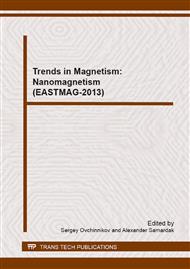[1]
J. Sudagar, J. Lian, and W. Sha, Electroless nickel, alloy, composite and nano coatings – A critical review, J. Alloys Compd. 571 (2013) 183–204.
DOI: 10.1016/j.jallcom.2013.03.107
Google Scholar
[2]
M. Yamakami and M. Kajihara, Solid-State Reactive Diffusion between Sn and Electroless Ni–P at 473 K, Mater. Trans. 50 (2009) 130–137.
DOI: 10.2320/matertrans.mra2008266
Google Scholar
[3]
S. Yoon, J. Kim, S. Jeong, and H. Lee, Effect of under bump metallurgy and reflows on shear strength and microstructure of joint between Cu substrate and Sn-36Pb-2Ag solder alloy, Mater. Trans. 44 (2003) 290–297.
DOI: 10.2320/matertrans.44.290
Google Scholar
[4]
K. G. Keong and W. Sha, Crystallizaton and phase transition behaviour of electroless nickel-phosphorus and their engineering properties, Surf. Eng. 18 (2002) 329–343.
DOI: 10.1179/026708402225010010
Google Scholar
[5]
R. C. Agarwala and V. Agarwala, Electroless alloy/composite coatings: A review, Sadhana 28 (2003) 475–493.
DOI: 10.1007/bf02706445
Google Scholar
[6]
R. S. Iskhakov, S. V. Komogortsev, A. D. Balaev, and L. A. Chekanova, Multilayer Co/Pd films with nanocrystalline and amorphous Co layers: Coercive force, random anisotropy, and exchange coupling of grains, Tech. Phys. Lett. 28 (2002) 725–728.
DOI: 10.1134/1.1511766
Google Scholar
[7]
R. S. Iskhakov, S. V Komogortsev, L. A. Chekanova, A. D. Balaev, V. A. Yuzova, and O. V. Semenova, The magnetic structure of ferromagnetic filaments of a CoNi(P) alloy in a porous silicon matrix, Tech. Phys. Lett. 29 (2003) 263–266.
DOI: 10.1134/1.1573285
Google Scholar
[8]
T. Osaka, M. Usuda, I. Koiwa, and H. Sawai, Effect of Phosphorus Content of the Magnetic and Electric Properties of Electroless Ni–P Film after Heat Treatment, Jpn. J. Appl. Phys. 27 (1988) 1885–1889.
DOI: 10.1143/jjap.27.1885
Google Scholar
[9]
K. Hüller and G. Dietz, The temperature dependence of the magnetization of Fe-P, Co-P and Ni-P alloys, J. Magn. Magn. Mater. 50 (1985) 250–264.
DOI: 10.1016/0304-8853(85)90060-5
Google Scholar
[10]
K. Hüller, G. Dietz, R. Hausmann, and K. Kölpin, The composition dependence of magnetization and curie temperature of Fe-P, Co-P and Ni-P, J. Magn. Magn. Mater. 53 (1985) 103–110.
DOI: 10.1016/0304-8853(85)90137-4
Google Scholar
[11]
L. M. Moreau, D. -H. Ha, C. R. Bealing, H. Zhang, R. G. Hennig, and R. D. Robinson, Unintended phosphorus doping of nickel nanoparticles during synthesis with TOP: a discovery through structural analysis., Nano Lett. 12 (2012) 4530–4539.
DOI: 10.1021/nl301642g
Google Scholar
[12]
Z. Guo, K. G. Keong, and W. Sha, Characterisation of crystallisation behaviour of electroless Ni-P plating during heating, Proceedings of the 4th International Symposium on Electronic Materials and Packaging (2002) 451–456.
DOI: 10.1109/emap.2002.1188881
Google Scholar
[13]
A. Brenner and G. Riddell, Nickel plating on steel by chemical reduction, J. Res. Natl. Bur. Stand. 37 (1946) 31-34.
DOI: 10.6028/jres.037.019
Google Scholar
[14]
K. Lu, M. L. Sui, and R. Lück, Supersaturation of phosphorus in nanophase nickel crystallized from an amorphous Ni-P alloy, Nanostructured Mater. 4 (1994) 465–473.
DOI: 10.1016/0965-9773(94)90118-x
Google Scholar
[15]
C. Kittel, On the Theory of Ferromagnetic Resonance Absorption, Phys. Rev. 73 (1948) 155–161.
Google Scholar


